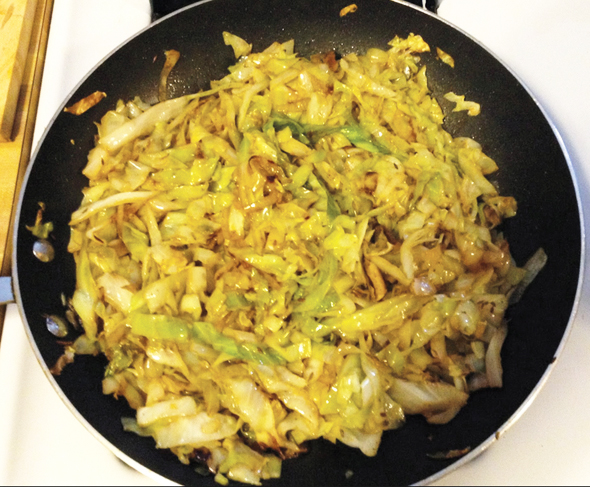Mama’s Punjabi Recipes: Bandh Gobi Te Wadiyan (Cabbage & Spicy Dumplings)
Some vegetables could be considered pretty drab if cooked by themselves, like gajjar (carrots), mutter (peas), tauri (zucchini) or bandh gobi (cabbage). These are generally quite inexpensive but to make them more tasty and desirable, they require the helping hand of some other ingredients, or sometimes be cooked together, like carrots and peas or cabbage and peas.
But Punjabis have a secret ingredient they can add to make these lowly vegetables more exciting, almost as western cuisine adds cheese or sauces to dress these up. And this secret ingredient is the Punjabi wadiyan (spicy lentil dumplings), which can bring in spiciness, tanginess and a little extra texture to the dish.
There is an art to knowing how to prepare the wadiyan and then how to cook them so that they enhance the food but do not crumble into tiny pieces. Punjabi wadiyan differ from the Gujarati type as they are generally made of skinless manh or urad daal (black lentils) with dhania (coriander), garam masala, lal mirch (red pepper), adrak (ginger) and hing (astafoetida powder). The Gujarati style are much smaller and made of skinless moong daal (yellow lentils) and don’t pack as much taste.
As with most types of cooking, timing is everything when using the wadiyan and the results speak for themselves when the dish is devoured! This dish is usually eaten with fresh roti.
Ingredients:
1 kg bandh gobi (green cabbage)
1 or 2 Punjabi wadiyan (lentil dumplings) – spiciness to taste
2 tbsp tael (olive oil or vegetable oil)
½ tsp sarson beej (mustard seeds)
½ tsp haldi (turmeric powder)
Spices to taste: 1 tsp namak (salt), 1 tsp mirch (red pepper), 1 tsp garam masala
Directions:
1. Cut the gobi into half and then chop into half inch strips, 2 inches long. Soak in water to wash and then pass through a strainer. Set it to the side.
2. Break the wadiyan into slightly smaller ½ inch pieces and keep to the side.
3. In a kadai (wok), heat the oil over medium setting then throw in the wadiyan and stir till they are slightly brown. Add the mustard seeds, turmeric, salt and pepper and mix well.
4. Now add the cut gobi and stir till it is coated. Cover and let it cook in its own steam for 5 minutes over high heat.
5. Check if the gobi has let off enough vapor and the wadi is tender. If there is some water, take off the cover and turn the heat to low till the water is reduced, in about 10 minutes. Stir gently to make sure it doesn’t stick.
6. When the gobi is tender, turn the heat off and the dish is ready. Keep covered and turn the heat down to very low for five more minutes. Sprinkle with garam masala and serve.
MAMA’S TIP OF THE WEEK
EASY WAY TO PEEL AND COOK BEET ROOT FOR A SALAD
Indians believe that chukandar (beetroots) are considered very beneficial to health as because it increases the blood in the body. There are practically no Indian recipes using beetroots though it is eaten sometimes as a salad.
But preparing the beetroots is a problem as your hands become red when you peel them, so it is best to use thin latex gloves when peeling beetroot. To cook, be sure to use a black, non-stick frying pan as the beetroot juice will stick to the surface and it will be very difficult to get sparkling clean. A stainless steel pan would be ruined!this as the baking soda will leave an after taste. It is better to soak the chole overnight and then letting them boil in the pot as they will take less time to become soft and have no after taste.
Shakuntla Malhotra is a skilled cook of Punjabi dishes made in the old-fashioned style that she learnt as a young woman in her ancestral home in Lyallpur, India before it became part of Pakistan after the Partition in 1947. People have often admired her cooking for its simplicity and taste that comes with each mouthful. Even in her mid-eighties, she continues to cook daily and agreed to share some of her delectable Punjabi recipes.


